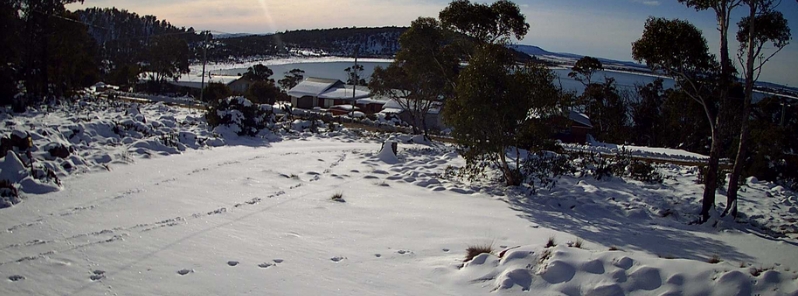‘Very significant’ cold blast brings rare snow, record temperatures to South Australia and Tasmania

A blast of wintry air brought rare snow to South Australia's Flinders Ranges and smashed low daily maximum temperatures at several locations in the state on Thursday, August 6. The cold snap also brought historic temperatures to Tasmania as Liawenee plunged to -14.2 °C (6.4 °F) on Friday, August 7, 2020– the state's coldest day since records began. The Bureau of Meteorology (BOM) labeled this week's weather as a "very significant event."
In South Australia, some of the locations that recorded lowest daily maximum temperatures on Thursday included Hawker, Whyalla, Yongala, and Port Augusta.
"Two annual records and eight August records for lowest daily maximum temperature were broken," BOM stated.
On Friday, rare snow blanketed the Flinders Ranges creating winter-like conditions to the red outback desert.
Staff from the Skytrek Willow Spring Station said although they had seen sow on the top of the hills before, it has not snowed much down in the valley.
According to BOM, a low near the NSW border is causing the unusually cold and wet conditions.
"Snow is falling about higher ground in the Flinders and Mid North, and this will continue through to early Saturday morning (August 8)."
Two annual records and 8 August records for lowest daily Maximum temperature were broken yesterday including at Woomera, Hawker, Whyalla, Yongala, Port Augusta, Moomba, Tarcoola and Minnipa. More records possible today. Check latest observations at https://t.co/Oexz75DgoJ pic.twitter.com/PiFNgPnzny
— Bureau of Meteorology, South Australia (@BOM_SA) August 7, 2020
It's snowing at Wilpena Pound in the Flinders Ranges this morning! Kerwin Moore has shared this incredible footage with the ABC of his morning view. What's it like at your place this morning? #snow #southaustralia #cold #winter#weather #snowinsouthaustralia pic.twitter.com/ScefvcdFU0
— ABC Adelaide (@abcadelaide) August 6, 2020

Liawanee, Tasmania recorded -14.2 °C (6.4 °F) at 06:01 LT, breaking the state's previous record of -13 °C (8.6 °F) set on June 30, 1983, at Tarraleah, Butlers Gorge and Shannon. By 07:02 LT, the temperature rose to -10.9 °C (12.4 °F).
BOM said this week's weather is "a very significant event." It was so cold that it was warmer at the Australian Antarctic research station in Casey on Thursday, meteorologist Simon Louis told ABC. "I don't think that would happen very often at all."
"Casey station in Antarctica it only got to -12 °C (10.4 °F), so it was actually colder up at Liawenee than it would have been at least at Casey in Antarctica last night," Louis added.
On Tuesday, August 4, Launceston saw more than 30 cm (12 inches) of snow– the most significant snowfall the city experienced since the early 1970s.
Oops, small typo, the -14.2 at Liawenee was recorded at 6:01 am not 8:01 am.https://t.co/EDUrvdTJmm
— Bureau of Meteorology, Tasmania (@BOM_Tas) August 7, 2020
Webcam pics from Swan Bay and Mt Mawson. Blue sky and snow! pic.twitter.com/YmMqoWlM5m
— Bureau of Meteorology, Tasmania (@BOM_Tas) August 7, 2020
Featured image credit: BOM Tasmania

Commenting rules and guidelines
We value the thoughts and opinions of our readers and welcome healthy discussions on our website. In order to maintain a respectful and positive community, we ask that all commenters follow these rules.